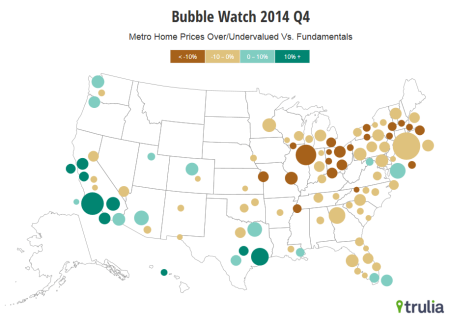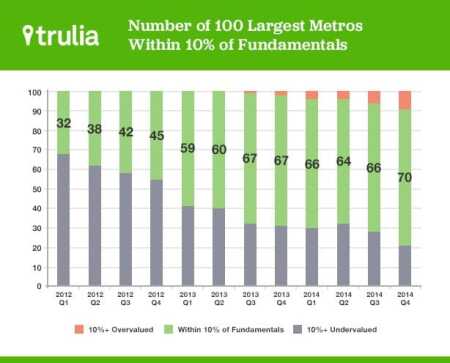Relative to fundamentals, U.S. home prices looked 2 percent undervalued in the fourth quarter of 2014. Home prices in 70 of the 100 largest metro areas are less than 10 percent over- or undervalued. That is the highest number of markets close to local long-term fundamentals since the recovery began, and a sign that the housing market is becoming more stable and healthy.
Trulia’s Bubble Watch shows whether home prices are overvalued or undervalued relative to fundamentals by comparing prices today with historical prices, incomes, and rents. The more prices are overvalued, the greater the chance that a bubble might be forming. Sharply rising prices aren’t necessarily a sign of a bubble. By definition, a bubble develops when prices look high relative to fundamentals.
Bubble-watching is as much an art as a science because there is no definitive measure of fundamental value. To try to put numbers on it, we look at the price-to-income ratio, the price-to-rent ratio, and prices relative to their long-term trends. We use multiple data sources, including the Trulia Price Monitor as a leading indicator of where home prices are heading. We combine these measures of fundamental value rather than relying on a single factor because no one measure is perfect. Trulia’s first Bubble Watch report, from May 2013, explains our methodology. This FAQ gives more detail for interpreting the results. The following is what we found this quarter.
Home Prices 2 Percent Undervalued Nationally
We estimate that home prices nationally were 2 percent undervalued in the fourth quarter of 2014. In the first quarter of 2006, at the height of the past decade’s housing bubble, home prices soared to 34 percent overvalued before dropping to 14 percent undervalued in the first quarter of 2012. One year ago, in the fourth quarter of 2013, prices looked 5 percent undervalued. This chart shows how far current prices are from a bubble:
Eight of the Ten Most Overvalued Markets Are in California and Texas
The most overvalued market in the country is now Austin, at 16 percent, followed by Orange County and Los Angeles in southern California. Nine of the 100 largest metro areas are 10 percent or more overvalued. Miami, the tenth-most-overvalued metro, rounds up to 10 percent, but is actually a hair below that level.
| Top 10 Metro Areas Where Home Prices Are Most Overvalued | ||||
| # | U.S. metro | Home prices relative to fundamentals, 2014 Q4 | Home prices relative to fundamentals, 2006 Q1 | Year-over-year change in asking prices, Dec. 2014 |
| 1 | Austin, TX | +16% | +2% | 12.2% |
| 2 | Orange County, CA | +15% | +65% | 6.1% |
| 3 | Los Angeles, CA | +13% | +73% | 7.0% |
| 4 | Honolulu, HI | +13% | +37% | 5.4% |
| 5 | San Francisco, CA | +12% | +47% | 9.5% |
| 6 | Riverside–San Bernardino, CA | +12% | +87% | 11.0% |
| 7 | San Jose, CA | +12% | +53% | 8.4% |
| 8 | Oakland, CA | +10% | +68% | 14.5% |
| 9 | Houston, TX | +10% | +1% | 13.4% |
| 10 | Miami, FL | +10% | +76% | 11.9% |
| Note: Among the 100 largest metro areas. Positive numbers indicate overvalued prices, negative numbers indicate undervalued prices. Click here to see the price valuation for all 100 metro areas: Excel or PDF. | ||||
All of the most undervalued metro areas today are in the Midwest and New England, led by Cleveland and Akron. But some of the most undervalued metro areas have recently had double-digit price increases, including Lake-Kenosha counties (just north of Chicago), Toledo, and Detroit.
| Top 10 Metro Areas Where Home Prices Are Most Undervalued | ||||
| # | U.S. metro | Home prices relative to fundamentals, 2014 Q4 | Home prices relative to fundamentals, 2006 Q1 | Year-over-year change in asking prices, Dec. 2014 |
| 1 | Cleveland, OH | -20% | +13% | 1.8% |
| 2 | Akron, OH | -17% | +12% | 0.6% |
| 3 | Dayton, OH | -17% | +8% | 4.9% |
| 4 | Lake-Kenosha counties, IL-WI | -16% | +25% | 12.7% |
| 5 | New Haven, CT | -16% | +32% | 2.6% |
| 6 | Toledo, OH | -15% | +16% | 10.2% |
| 7 | Hartford, CT | -15% | +20% | 3.7% |
| 8 | Fairfield County, CT | -14% | +30% | 1.0% |
| 9 | Worcester, MA | -14% | +39% | 2.0% |
| 10 | Detroit, MI | -14% | +33% | 12.9% |
| Note: Among the 100 largest metro areas. Positive numbers indicate overvalued prices, negative numbers indicate undervalued prices. Click here to see the price valuation for all 100 metro areas: Excel or PDF. | ||||
Today’s most overvalued markets are generally less affordable than the most undervalued markets. Nevertheless, overvaluation and undervaluation aren’t necessarily the same as affordability. Our valuation measure looks at local prices relative to what’s normal historically in each local market. Right now, New York and Boston both look several percentage points undervalued relative to long-term fundamentals, even though they’re far more expensive than Houston or Austin on a price-per-square-foot basis. What’s more, in the past, extremely affordable markets such as Detroit sometimes looked overvalued relative to local fundamentals, while very expensive markets such as San Francisco looked undervalued.
Prices Look Healthier Than at Any Point in Recovery
As of the fourth quarter of 2014, prices in 70 of the 100 largest metro areas were within 10 percent of fundamentals—that is, they were neither overvalued nor undervalued by more than 10 percent. Among the 100 largest metro areas, only nine were overvalued by more than 10 percent, and 21 were undervalued by more than 10 percent. The number of markets within 10 percent of fundamentals is at its highest level since prices hit bottom in early 2012.
Even better, home prices may be leveling off in healthy territory—in other words, without the national housing market moving back into bubble range. In 2006, nearly half of large metro areas were more than 30 percent overvalued. No large metro area comes close to that degree of overvaluation today. Price increases are slowing nationally, well before a bubble has formed. The trend is visible in most metro areas, particularly those that had the most severe housing bust in the past decade and unsustainably fast price rebounds more recently. And we expect price increases to keep slowing in 2015. Bubble-watchers can continue to rest easy.







